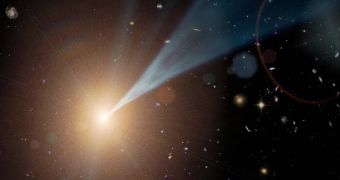Astronomers operating the NASA Wide-field Infrared Survey Explorer (WISE) telescope say that a survey the observatory conducted before its mission ended has now revealed more than 200 blazars.
These structures can be best described as very compact quasi-stellar radio sources (quasars). Their name is meant to express the idea of a blazing quasar. Blazars are located at the core of active galactic nuclei (AGN), and represent some of the most energetic phenomena in the entire Universe.
Like quasars, blazars too are powered by supermassive black holes located in the central regions of the AGN. Astronomers believe these structures are produced by material falling into the black hole, from its accretion disk.
Scientists have been trying to identify a significant sample of blazars for study for a long time, but thus far progress has been slow. Now, they say that WISE has the ability to reveal thousands more blazars, in addition to the 200+ whose location it already pinpointed.
One of the things that separates this class of structures from other supermassive black holes is the fact that the jets of radiation they release as a direct result of their feeding process are aimed straight at us.
“Blazars are extremely rare because it's not too often that a supermassive black hole's jet happens to point towards Earth,” says principal study investigator, Francesco Massaro. Details of the work were published in a series of papers that appears in the esteemed Astrophysical Journal.
“We came up with a crazy idea to use WISE's infrared observations, which are typically associated with lower-energy phenomena, to spot high-energy blazars, and it worked better than we hoped,” he adds.
What scientists are especially interested in learning is how super-fast jets work, and what the physics behind their behavior is. At the same time, this could help experts figure out how the earliest black holes evolved in the Universe.
The first WISE data batch was released in April 2011, while the remaining information was made available to the scientific community in March 2012. The researchers behind the new study used the first part of the all-sky dataset the telescope compiled.
Massaro and his team were interested only in proving that infrared telescopes such as WISE can be used to find high-energy objects.
“We had no idea when we were building WISE that it would turn out to yield a blazar gold mine. That's the beauty of an all-sky survey. You can explore the nature of just about any phenomenon in the Universe,” NASA Jet Propulsion Laboratory WISE project scientist, Peter Eisenhardt, comments.

 14 DAY TRIAL //
14 DAY TRIAL //